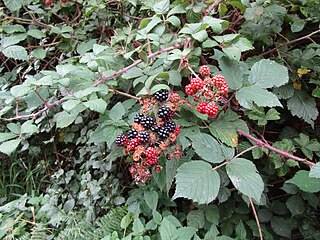
Rubus is a large and diverse genus of flowering plants in the rose family, Rosaceae, subfamily Rosoideae, with over 1,350 species, commonly known as brambles.
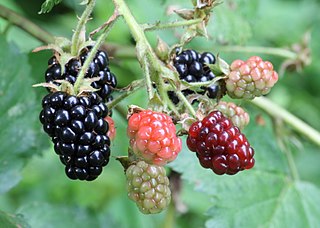
The blackberry is an edible fruit produced by many species in the genus Rubus in the family Rosaceae, hybrids among these species within the subgenus Rubus, and hybrids between the subgenera Rubus and Idaeobatus. The taxonomy of blackberries has historically been confused because of hybridization and apomixis, so that species have often been grouped together and called species aggregates. For example, the entire subgenus Rubus has been called the Rubus fruticosus aggregate, although the species R. fruticosus is considered a synonym of R. plicatus.

The dewberries are a group of species in the genus Rubus, section Rubus, closely related to the blackberries. They are small trailing brambles with aggregate fruits, reminiscent of the raspberry, but are usually purple to black instead of red.

The raspberry is the edible fruit of a multitude of plant species in the genus Rubus of the rose family, most of which are in the subgenus Idaeobatus. The name also applies to these plants themselves. Raspberries are perennial with woody stems.

Rubus spectabilis, the salmonberry, is a species of bramble in the rose family Rosaceae, native to the west coast of North America from west-central Alaska to California, inland as far as Idaho. Like many other species in the genus Rubus, the salmonberry plant bears edible fruit, typically yellow-orange or red in color, resembling raspberries in appearance.

Rubus caesius is a Eurasian species of dewberry, known as the European dewberry. Like other dewberries, it is a species of flowering plant in the rose family, related to the blackberry and raspberry. It is widely distributed across much of Europe and Asia from Ireland and Portugal as far east as Xinjiang Province in western China. It has also become sparingly naturalized in scattered locations in Argentina, Canada, and the United States.

Rubus saxatilis, or stone bramble, is a species of bramble widespread across Europe and Asia from Iceland and Spain east as far as China. It has also been found in Greenland.

Rubus pensilvanicus, known commonly as Pennsylvania blackberry, is a prickly bramble native to eastern and central North America from Newfoundland south to Georgia, west as far as Ontario, Minnesota, Nebraska, Missouri, and Arkansas. The species is also established as a naturalized plant in California.
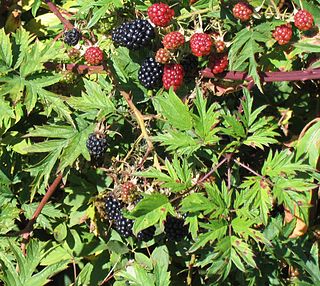
Rubus laciniatus, the cutleaf evergreen blackberry or evergreen blackberry, is a species of Rubus, native to Eurasia. It is an introduced species in Australia and North America. It has become a weed and invasive species in forested habitats in the United States and Canada, particularly in the Northeast and along the Pacific Coast.

Rubus armeniacus, the Himalayan blackberry or Armenian blackberry, is a species of Rubus in the blackberry group Rubus subgenus Rubus series Discolores Focke. It is native to Armenia and northern Iran, and widely naturalised elsewhere. Both its scientific name and origin have been the subject of much confusion, with much of the literature referring to it as either Rubus procerus or Rubus discolor, and often mistakenly citing its origin as western European. Flora of North America, published in 2014, considers the taxonomy unsettled, and tentatively uses the older name Rubus bifrons.

Rubus ulmifolius is a species of wild blackberry known by the English common name elmleaf blackberry or thornless blackberry and the Spanish common name zarzamora. It is native to Europe and North Africa, and has also become naturalized in parts of the United States, Australia, and southern South America.
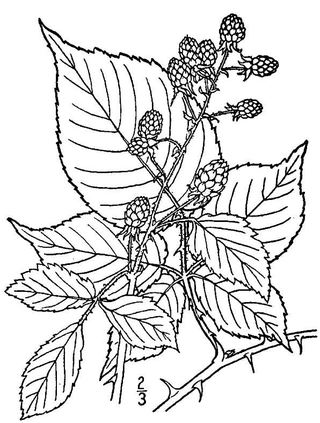
Rubus allegheniensis is a North American species of highbush blackberry in Section Alleghenienses of the genus Rubus, a member of the rose family. It is the most common and widespread highbush blackberry in eastern and central North America. It is commonly known as Allegheny blackberry.
Phytophthora bilorbang is a non-papillate homothallic plant pathogen known to infect Rubus anglocandicans in Western Australia. It produces non-papillate sporangia, oogonia with smooth walls containing thick-walled oospores, as well as paragynous antheridia.

Rubus vestitus is a European species of brambles in the rose family, called European blackberry in the United States. It is native to Europe and naturalized along the northern Pacific Coast of the United States and Canada.

Rubus nessensis is a species of bramble native to Northwestern Europe, including Great Britain and Ireland. Two subspecies are recognized: R. n. nessensis and R. n. cubirianus.
Rubus septentrionalis is a species of bramble widely distributed in Northern Europe. It grows at higher latitudes than most other brambles.
Rubus gratus is a species of bramble found across much of Northwest Europe.
Rubus dasyphyllus is a species of bramble found in northwest Europe, including Belgium, Denmark, Germany, the Netherlands, and the British Isles. It may be extinct in Sweden.
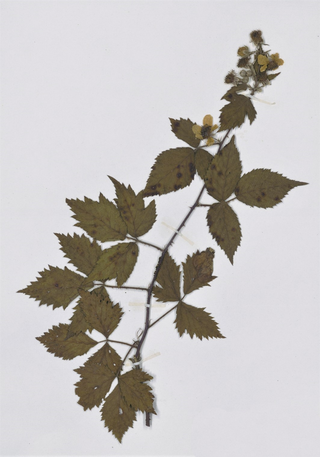
Rubus pyramidalis is a species of bramble, a flowering plant in the rose family, native to northwest Europe.

Diastrophus rubi is a species of gall wasp in the family Cynipidae that live on the stems of bramble. The insect was first described by the German entomologist Peter Friedrich Bouché in 1834 and is found in Europe.















